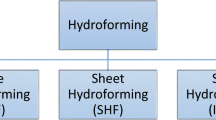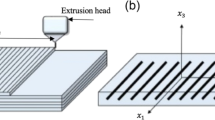Abstract
Stub ends are used to connect pipes in piping arrangements and are generally manufactured by welding two sub-components. This welding process is time consuming and causes pollution. Stub ends can also be produced without welding via a general spinning process using thicker pipe; however, the production cost is high, because different forming dies must be prepared in order to obtain various stub end sizes. Material loss also occurs. A flexible manufacturing process that does not use forming dies is proposed in this paper. The stub-end shape is formed by rolling dies instead of an outer mold. During this process, the lap roller motion is dependent on the required degree of forming. To determine the effects of the process parameters and to identify the optimal process, a commercial finite-element-method (FEM) code, DEFORM Ver. 11.0, is employed here. The lap-guide and lap-roller movement speeds are the main process parameters. Based on the simulation results, a 3-inch stub end meeting the ASME B16.9-2007 code requirements is fabricated. After production, the forming load is examined and the measured pressure on the ring roller is found to agree with the calculated value. The dimensions of each part of the stub end also satisfy requirements.
Similar content being viewed by others
Abbreviations
- G:
-
stub-end lap diameter
- R:
-
stub-end fillet radius
- T:
-
stub-end lap thickness
- vLR :
-
movement speed of lab roller
- t:
-
process time
References
Kim, J. S., Cho, J. R., and Jeong, H. S., “Manufacturing Method of Long-Neck Flange,” KR Patent, No. 100688066, 2007.
Jeong, H. S., Son, C. W., Oh, J. S., Choi, S. K., and Cho, J. R., “Friction Welding Process Analysis of Piston Rod in Marine Diesel Engine and Mechanical Properties of Welded Joint,” Transactions of Materials Processing, Vol. 20, No. 3, pp. 236–242, 2011.
Cho, G. R., Bae, W. B., and Choi, G. D., “Pipe Joint Forming Method by Local Rapid-Heating,” KR Patent, No. 100424335, 2003.
The American Society of Mechanical Engineers, “Factory-Made Wrought Buttwelding Fittings,” ASME B16.9-2007, 2007.
Kastuteru, A., Manufacturing Method of Lap-Joint Pipe, JP Patent, No. Shou64-71527, 1989 (in Japanese).
Park, H. W., Kwon, J. H., Kim, J. S., and Cho, J. R., “The Development of Manufacturing Method of Integrated Lap Joint by Spinning Process,” Proc. of Korean Society for Technology of Plasticity Spring Conference, pp. 163–166, 2010.
Faraji, G., Mashhadi, M., Dizadji, A., and Hamdi, M., “A Numerical and Experimental Study on Tubular Channel Angular Pressing (TCAP) Process,” Journal of Mechanical Science and Technology, Vol. 26, No. 11, pp. 3463–3468, 2012.
Hong, L. P., “The Development of Manufacturing Method using Spinning Process of Integrated Stubend for Piping Connection,” M.Sc. Thesis, Department of Mechanical Engineering, Koran Maritime and Ocean University, 2013.
Gwak, G.-Y., Jeon, J.-W., Cho, J.-R., Choi, J.-Y., and Kim, J.-S., “Development of Integrated Stub End by Spinning Process,” Int. J. Precis. Eng. Manuf., Vol. 16, No. 7, pp. 1473–1477, 2015.
Park, J. E., Han, C. S., Choi, S. W., Kim, S. S., and Na, K. H., “The Spinnability of Multi-step Cylindrical Cup in Spinning Process,” Proc. of KSPE Autumn Conference, pp. 1016–1020, 2001.
Kang, J. S., Park, G. S., and Kang, E. S., “Design of Hydraulic & Control System for the Disc Spinning Machine,” J. Korean Soc. Precis. Eng., Vol. 19, No. 9, pp. 157–165, 2002.
Lee, H. W., Hwang, D. W., Song, S. A., and Kim, C., “A Study on the Improvement of Hot Spinning Process for Weight Lighting of CNG Vessel (Type II),” Proc. of KSPE Spring Conference, pp. 135–136, 2012.
Jeong, D. S., Kim, S. T., Choi, D. B., Ye, S. B., and Seol, S. S., “A Study on the Thermal Characteristics of Spindle for the Spinning Machine,” Proc. of KSPE Spring Conference, pp. 565–569, 2005.
Kim, Y. H., Park, J. W., and Cho, H. S., “An Analysis of Tube Spinning for Shock Absorber on Vehicles,” J. Korean Soc. Precis. Eng., Vol. 17, No. 3, pp. 33–38, 2000.
Author information
Authors and Affiliations
Corresponding author
Rights and permissions
About this article
Cite this article
Gwak, GY., Cho, JR., Choi, JY. et al. Forming-die-free integrated stub-end manufacturing process using spinning. Int. J. Precis. Eng. Manuf. 17, 679–684 (2016). https://doi.org/10.1007/s12541-016-0083-z
Received:
Revised:
Accepted:
Published:
Issue Date:
DOI: https://doi.org/10.1007/s12541-016-0083-z




